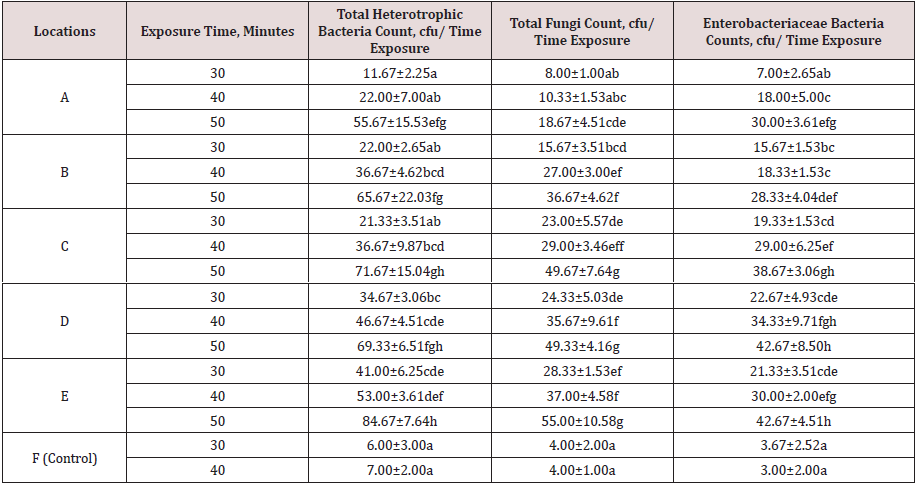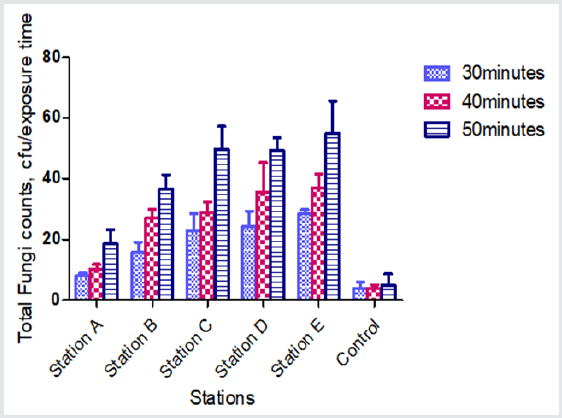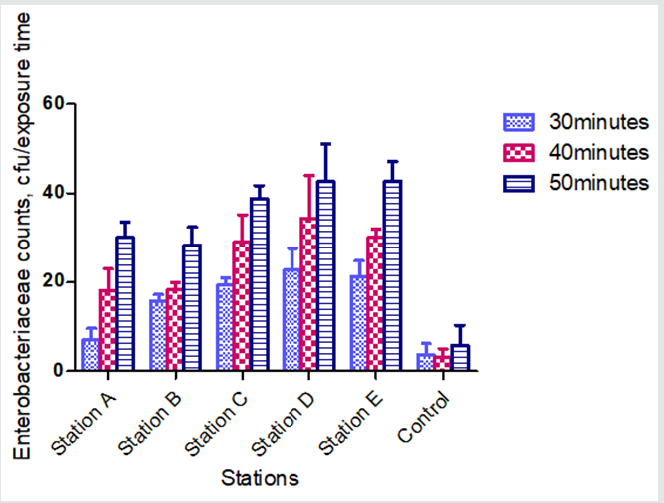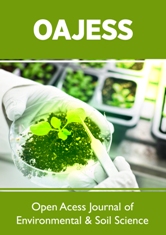
Lupine Publishers Group
Lupine Publishers
Menu
ISSN: 2641-6794
Research Article2641-6794 
Time Impact on Spatio -Temporal Density of Microbial Air Contaminants in the Dewatering Zone of Smallholder Gari Processing Facility in the Niger Delta Region of Nigeria Volume 4 - Issue 5
Enetimi Idah Seiyaboh1, Glory Richard2 and Sylvester Chibueze Izah3*
- 1Department of Biological Sciences, Niger Delta University, Nigeria
- 2Department of Community Medicine, Niger Delta University, Nigeria
- 3Department of Biology, Bayelsa Medical University, Nigeria
Received: February 24, 2020; Published: March 10, 2020
Corresponding author: Sylvester Chibueze Izah, Department of Biology Bayelsa Medical University, Nigeria
DOI: 10.32474/OAJESS.2020.04.000198
Abstract
This study investigated the time impact of spatio -temporal microbial density of air contaminants in the dewatering zone of smallholder gari processing facility in the Niger Delta region of Nigeria. Triplicate petri dishes containing solidified Nutrient Agar, Saboraud Agar and MacConkey agar were exposed for 30, 40 and 50 minutes within 2-meter radius of the facility at the dewatering stage of gari processing at a height of 2.5 feet above ground. The agar plates were incubated, and the resulting microbial density determined. Results showed that the density of the microbes were in the range of 11.67 -34.67cfu/30 minutes, 22.00 -53.00cfu/40 minutes and 55.67 -84.67cfu/50 minutes, for total heterotrophic bacteria; 8.00 -24.33cfu/30 minutes, 10.33 -37.00 cfu/40 minutes and 18.67 -55.00cfu/50 minutes, for total fungi, and 7.00 -22.67cfu/30 minutes, 18.00 -34.00cfu/40 minutes and 30.00 -43.67cfu/50 minutes, for enterobacteriaceae counts. Statistically, there were significant variations (p<0.05) across the locations and time. The occurrence of bacteria from the enterobacteriaceae family may have stemmed from the fact that domestic animals such as goats, fowls and even rats move freely within the mills in search of food. The overall high density of microbes is attributable to the exposure time in the dewatering phase of gari processing. The researchers concluded that vulnerable individuals (immunosuppressed\ or compromised, children and elderly) may be susceptible certain disease conditions through bioaerosol inhalation.
Keywords: Bioaerosol, Cassava processing, Environmental contaminants, Public health
Introduction
Air is an integral part of the components of the environment. Air
pollutants majorly emanate from human activities and to a lesser
extent from natural processes. Air pollutants have the tendency to
alter the biotic constituents of an ecosystem which impact on the
flora and fauna of the ecosystem in a manner peculiar to the toxicity
of the pollutants. Meteorological indicators such as wind speed and
direction, temperature etc. may have an effect on the dispersal and
absorption rate of air pollutants. In addition, exposure duration
may have an effect on the toxicity of air pollutants. Microorganisms
are found in diverse environments including soil, sediments, water,
and air. The ubiquitous presence of microbes is a major concern in
hospitals, food processing units and other sectors where sterility is
required, prompting strict control measures aimed at eradicating
or minimizing their presence. Authors have defined bio-aerosols as
airborne particulate containing living organisms such as microbes
or originating from living organisms, such as metabolites, toxins
or fragments of microorganisms [1-4]. As such bio-aerosols are
obtained in several environmental conditions including waste
dumpsites, processing units among others.
Cassava processing into gari is among the major sources of
livelihood of several families in southern Nigeria. Gari production is
mostly carried out by smallholders using rudimentary equipment.
Gari is produced with the following steps: peeling, washing off of
debris, grating, bagging, dewatering/ pressing, sieving and frying
[5,6]. During dewatering/ pressing large amounts of wastewater
often called cassava mill effluents are generated [6-8]. In the
environment, the effluent often decomposes through the activities
of indigenous microbes [6,9]. During this process offensive odors
are perceived few distances away from the dewatering zone. In
addition, the effluents have shown to alter the physicochemical and
biological characteristics of the receiving soil [10].
Authors have identified Staphylococcus aureus, Escherichia
coli, Pseudomonas aerugionsa, Bacillus, Micrococcus, Klebsiella,
Streptococcus, Chromobacterium, Proteus, Enterobacter, Aspergillus,
Penicillium, Mucor, Rhizopus species and Saccharomyces cerevisiae
in cassava mill effluent contaminated soil [10-14] Some species of
these microbes have been reported to cause diseases in animals and
humans especially immune- compromised individuals. In addition,
some of these microbes may likely be the microbes found in gari
processing facilities. Again, authors have reported Escherichia coli,
Staphylococcus aureus, Micrococcus, Staphylococcus, Streptococcus,
Pseudomona, Klebsiella and Bacillus species, and Absidia, Alternaria,
Cladosporium, Fusarium, Aspergillus, Geotrichum, Mucor, Penicillium,
Phoma, Rhizopus, Curvularia species and Candida albicans as
microbial bio-aerosol found in waste dumpsite in some regions in
southern Nigeria [3,15].
The vast presence of microbes and the crucial role they play
in public health issues, has necessitated this study focusing on
the microbial density of air contaminants in the dewatering zone
of smallholder gari processing facility in the Niger Delta region of
Nigeria.
Materials and Methods
Study Area
This study was carried out in a smallholder cassava grating mill in the Niger Delta region of Nigeria. Gari production from cassava tubers is carried out using rudimentary equipment. Cassava farming and processing together with other food crops such as yam, maize etc. is the main source of livelihood to the upland people of the Niger Delta. The climate of the area is similar to other Niger Delta areas with relative humidity and temperature within 50 -95% and 28 ±8 °C, respectively all year round [6,7,16]. Two major seasons (viz: wet and dry) occur in the area.
Field Sampling and Analysis
Microbial density was determined using sedimentation method. The media was prepared and labelled accordingly as Nutrient agar (for the enumeration of total heterotrophic bacteria), Saboraud dextrose agar (for the enumeration of total fungi) and MacConkey’s Agar for the enumeration of bacteria belonging to the enterobacteriaceae family. The agar was prepared according to the manufacturers guide and it contained approximately 20mls of prepared agar. Triplicate petri dishes containing the solidified agars were exposed for 30, 40 and 50 minutes at the dewatering area of the cassava processing mills/ Locations. Stations A, B, C, D, E (experiment) and station F (control) where established at a suspended height of 2.5 feet. Thereafter, the exposed agar plates were incubated at room temperature for 24 -48 hours for bacteria and 4 -5 days for fungi. The density of the microbes was determined according to the [17,18].
Statistical Analysis
Statistical Package for Social Sciences was used to carry out the statistical analysis. The data was expressed as mean± standard deviation. One way-analysis of variance was used to show significant deviation at P=0.05 across the locations, and Waller - Duncan statistics was used to discern the source of disparity.
Results and Discussion
Spatio-temporal and time effects on the bioaerosol density in the dewatering zone of smallholder gari production from cassava tuber in the Niger Delta region of Nigeria are presented in Table 1. The density of the total heterotrophic bacteria counts at Locations A, B, C, D, E and F were 11.67±2.25 cfu/30 minutes, 22.00±2.65 cfu/30 minutes, 21.33±3.51 cfu/30 minutes, 34.67±3.06 cfu/30 minutes, 41.00±6.25 cfu/30 minutes and 6.00±3.00 cfu/30 minutes, respectively for 30 minutes exposure time interval, 22.00±7.00 cfu/40 minutes, 36.67±4.62 cfu/40 minutes, 36.67±9.87 cfu/40 minutes, 46.67±4.51 cfu/40 minutes, 53.00±3.61 cfu/40 minutes and 7.00±2.00 cfu/40 minutes, respectively for 40 minutes exposure time interval, and 55.67±15.53 cfu/50 minutes, 65.67±22.03 cfu/50 minutes, 71.67±15.04 cfu/50 minutes, 69.33±6.51 cfu/50 minutes, 84.67±7.64 cfu/50 minutes and 7.67±2.08 cfu/50 minutes, respectively for 50 minutes exposure time interval. Statistically, there were significant discrepancies (p<0.05) across the locations and time. In each of the locations, there was an increase in the density of the total heterotrophic bacteria counts as the exposure time interval increased (Figure 1), though statistically significant across some locations.
Table 1: Spatio - temporal and time effects on the bioaerosol density in the dewatering zone of smallholder gari processing facility in the Niger Delta region of Nigeria.

Data are expressed as mean ± standard deviation; Different letters along the column indicate significant deviation at p<0.05 according to Waller Duncan statistics
Figure 1: Spatio - temporal and time effects of total heterotrophic bacteria density in the dewatering zone of smallholder gari processing facility in the Niger Delta region of Nigeria.

Figure 2: Spatio - temporal and time effects of total fungi density in the dewatering zone of smallholder gari processing facility in the Niger Delta region of Nigeria.

The density of the total fungi counts at Locations A, B, C,
D, E and F were 8.00±1.00cfu/30 minutes, 15.67±3.51 cfu/30
minutes, 23.00±5.57 cfu/30 minutes, 24.33±5.03 cfu/30 minutes,
28.33±1.53 cfu/30 minutes and 4.00±2.00 cfu/30 minutes,
respectively for 30 minutes exposure time interval, 10.33±1.53
cfu/40 minutes, 27.00±3.00 cfu/40 minutes, 29.00±3.46 cfu/40
minutes, 35.67±9.61 cfu/40 minutes, 37.00±4.58 cfu/40 minutes
and 4.00±1.00 cfu/40 minutes, respectively for 40 minutes exposure
time interval, and 18.67±4.51 cfu/50 minutes, 36.67±4.62 cfu/50
minutes, 49.67±7.64 cfu/50 minutes, 49.33±4.16 cfu/50 minutes,
55.00±10.58 cfu/50 minutes and 5.00±3.61 cfu/50 minutes,
respectively for 50 minutes exposure time interval. There were
significant discrepancies (p<0.05) across the locations and time.
For each of the locations, the total fungi count increased with an
increase in exposure time interval (Figure 2), which was significant
for some Locations as shown by post hoc test (Table 1).
The density of the enterobacteriaceae counts at Locations A, B,
C, D, E and F were 7.00±2.65 cfu/30 minutes, 15.67±1.53 cfu/30
minutes, 19.33±1.53cfu/30 minutes, 22.67±4.93 cfu/30 minutes,
21.33±3.51 cfu/30 minutes and 3.67±2.52 cfu/30 minutes,
respectively for 30 minutes exposure time interval, 18.00±5.00
cfu/40 minutes, 18.33±1.53 cfu/40 minutes, 29.00±6.25 cfu/40
minutes, 34.33±9.71 cfu/40 minutes, 30.00±2.00 cfu/40 minutes
and 3.00±2.00 cfu/40 minutes, respectively for 40 minutes exposure
time interval, and 30.00±3.61 cfu/50 minutes, 28.33±4.04 cfu/50
minutes, 38.67±3.06 cfu/50 minutes, 42.67±8.50 cfu/50 minutes,
42.67±4.51 cfu/50 minutes and 5.67±4.62 cfu/50 minutes,
respectively for 50 minutes exposure time interval. There were
significant discrepancies (p<0.05) across the locations and time. A
significant increase exists as the exposure time interval increases
for most of the locations in addition to the apparent elevation in the
density of the enterobacteriaceae counts that occurred as exposure
increased (Figure 3).
Figure 3: Spatio - temporal and time effects of Enterobacteriaceae density in the dewatering zone of smallholder gari processing facility in the Niger Delta region of Nigeria.

This study showed that there is significant dissimilarity across the locations. This may be due to the fact that some of the mills are located close to dumpsites also other anthropogenic activities close to the dewatering area may have contributed to the variation in the microbial density across the locations. Climatic factors such as wind speed and direction during sampling may also a role in the observed deviation for each of the locations. In a related study, Angaye et al. [19] reported higher total heterotrophic bacteria (49-73cfu/50 minutes) in dry season in contrast with the value (44-51cfu/30 minute) in wet season from waste dumpsite in the Niger Delta region of Nigeria. The authors further reported total fungi and enterobacteriaceae as 24-37 and 22-43 cfu/50 minutes, respectively in dry season, and 17-37cfu/50 minutes and 20-31 cfu/50 minutes, respectively in wet season. Across the stations, station F (control) had the least microbial density for each of the microbial groups (total heterotrophic bacteria, total fungi and Enterobacteriaceae counts) measured implicating dewatering as a possible reason for the increased microbial density at gari processing facilities particularly in the study area. The presence of microbial population in the control could be due to the ubiquitous nature of most microorganisms. This study also showed that as the exposure duration increased, the density of each group of microbes under study increased. Again, this suggests the effect of time on the microbial density of the air within the dewatering unit during cassava processing to gari. The occurrence of Enterobacteriaceae counts may be associated with fecal coliforms present in the vicinity of the study area arising from domestic animals such as goats and fowls which often move freely within the vicinity of the mills in search of food.
Conclusion
Gari production by small scale processors in the Niger Delta is carried out using rudimentary equipment. Cassava production and processing into different products is among the sources of livelihood to several families especially those ones in the upland region. This study evaluated the time related spatio - temporal impact of the density of microbial air contaminants from the dewatering stage of gari processing. This study also showed that microbial air contaminants arising from the dewatering stage of gari production by smallholder processor tends to differ from one mill to another and also dependent on duration of exposure.
References
- ACGIH (1999) Bio-aerosols: Assessment and Control. American Conference of Governmental Industrial Hygienists, Cincinnati, Hamilton, USA.
- USEPA (2004) Risk Assessment Evaluation for Concentrated Animal Feeding Operations, (Edn.),Haines J, Staley L (Eds.), U.S. Environmental Protection Agency, Office of Research and Development, National Risk Management Research Laboratory, Cincinnati, Hamilton.
- Ambrose IS, Nweke CO, Umeh SCI, Essien JP, Akpan PE (2014) Bioaerosols load, spatial distribution and quality in the outdoor air environment of Uyo urban in Akwa Ibom State, Nigeria. World J Sci Tech 6: 145 -153.
- Ambrose I, Braid W, Essien JP (2015) Assessment of Air Quality (Bioaerosols) of the Municipal Waste Dumpsite in Uyo Urban, Akwa Ibom State, Nigeria. International Journal of Scientific and Research Publications 5(9): 1- 6.
- Izah SC (2018) Estimation of Potential Cassava Mill Effluents Discharged into Nigerian Environment. EnvironAnal Eco stud 2(5).
- Richard G (2019) Influence of Season on the Distribution of Volatile Organic Compounds from Small-Holder Cassava Processing Facility in the Niger Delta Region of Nigeria. Annals of Ecology and Environmental Sciences3(4): 27-35.
- Izah SC, Bassey SE, Ohimain EI (2017) Changes in the treatment of some physico-chemical properties of cassava mill effluents using Saccharomyces cerevisiae. Toxic 5(4): 28.
- Izah SC, Bassey SE, Ohimain EI (2017) Assessment of pollution load indices of heavy metals in cassava mill effluents contaminated soil:a case study of small-scale cassava processing mills in a rural community of the Niger Delta region of Nigeria. Bioscience Methods 8(1): 1-17.
- Izah SC, Enaregha EB, Epidi JO (2019) Changes in in-situ water characteristics of cassava wastewater due to the activities of indigenous microorganisms. MOJ Toxicol 5(2):78-81.
- Izah SC, Aigberua AO (2017) Assessment of Microbial Quality of Cassava Mill Effluents Contaminated Soil in a Rural Community in the Niger Delta, Nigeria. EC Microbiology 13(4): 132-140.
- Igbinosa EO, Igiehon ON (2015) The impact of cassava effluent on the microbial and physicochemical characteristics on soil dynamics and structure. Jordan Journal of Biological Sciences 8(2): 107-112.
- Ezeigbo OR, Ike-Amadi CA, Okeke UP, Ekaoko MU (2014) The effect of cassava mill effluent on soil microorganisms in Aba, Nigeria. International Journal of Current Research in Bioscience and Plant Biology 1(4): 21-26.
- Eze VC, Onyilide DM (2015) Microbiological and physiochemical characteristics of soil receiving cassava effluents in Elele, Rivers state, Nigeria. Journal of Applied and Environmental Microbiology3(1): 20 -24.
- Okechi RN, Ihejirika CE, Chiegboka NA, Chukwura EI, Ibe IJ (2012) Evaluation of the effects of cassava mill effluents on the microbial populations and physicochemical parameters at different soil depths. International Journal of Bioscience 2(12): 139 -145.
- Igborgbor JC, Ogu GI (2015) Microbial Assessment of Air in The Vicinity of Some Dump Sites in Delta State. International organization of Scientific Research 5(1): 7 -15.
- Izah SC, Bassey SE, Ohimain EI (2017a) Assessment of heavy metal in cassava mill effluent contaminated soil in a rural community in the Niger Delta region of Nigeria. EC Pharmacology and Toxicology 4(5): 186-201.
- Benson HJ (2002) Microbiological Applications: Laboratory Manual in General Microbiology. complete version, (5thedn), McGaraw-Hill, New York, USA.
- Pepper IL, Gerba CP (2005) Environmental microbiology. A laboratory manual. (Second edn), Elsevier academic press.
- Angaye TCN, Zige DV, Mieseigha TA (2018) Spatial and seasonal assessment of bioaerosols associated with municipal solid wastes in yenagoa metropolis. MOJ Toxicol 4(5):361-363.

Top Editors
-

Mark E Smith
Bio chemistry
University of Texas Medical Branch, USA -

Lawrence A Presley
Department of Criminal Justice
Liberty University, USA -

Thomas W Miller
Department of Psychiatry
University of Kentucky, USA -

Gjumrakch Aliev
Department of Medicine
Gally International Biomedical Research & Consulting LLC, USA -

Christopher Bryant
Department of Urbanisation and Agricultural
Montreal university, USA -

Robert William Frare
Oral & Maxillofacial Pathology
New York University, USA -

Rudolph Modesto Navari
Gastroenterology and Hepatology
University of Alabama, UK -

Andrew Hague
Department of Medicine
Universities of Bradford, UK -

George Gregory Buttigieg
Maltese College of Obstetrics and Gynaecology, Europe -

Chen-Hsiung Yeh
Oncology
Circulogene Theranostics, England -
.png)
Emilio Bucio-Carrillo
Radiation Chemistry
National University of Mexico, USA -
.jpg)
Casey J Grenier
Analytical Chemistry
Wentworth Institute of Technology, USA -
Hany Atalah
Minimally Invasive Surgery
Mercer University school of Medicine, USA -

Abu-Hussein Muhamad
Pediatric Dentistry
University of Athens , Greece

The annual scholar awards from Lupine Publishers honor a selected number Read More...




